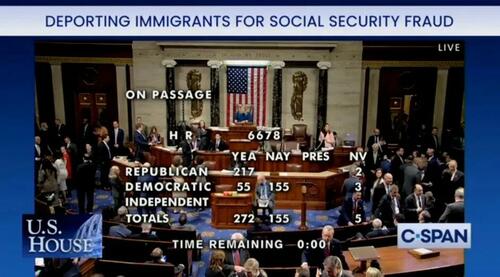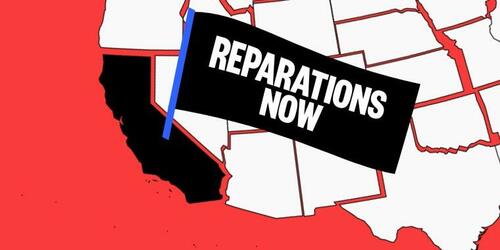Authored by Jeffrey Tucker via The Brownstone Institute,
The United States has the distinction the world over for being a home to the First Amendment, which guarantees free expression. And yet a mere seven years after its ratification in 1791, Congress violated it in the most severe way with the “Alien and Sedition Acts” of 1798, which made it a crime to engage in “false, scandalous, and malicious writing” against government officials.

The Sedition Act mentioned Congress, the President (John Adams), government generally as protected, but was silent about the Vice President, who was Thomas Jefferson. Upon the election of Jefferson in 1800, it was repealed immediately. Indeed, the censorship was so controversial that Jefferson’s opposition contributed to his victory.
The experience taught an important lesson. Governments have a tendency to want to control speech, meaning writing in those days, even if it means trampling on the rules that bind them. This is because they have an insatiable desire to manage the public mind, which is the story people carry around that can make the difference between stable rule and popular discontent. It has always been thus.
We like to think that free speech is settled doctrine but that’s not true. Thirty-five years after Jefferson’s victory, in 1835, the U.S. Post Office banned the circulation of abolitionist materials in the South.
This went on for 14 years until the ban was lifted in 1849.
Then 12 years later, President Abraham Lincoln revived censorship after 1860, imposing criminal penalties on newspaper editors that supported the Confederacy and opposed the draft. Once again, people who disagreed with regime priorities were considered seditious.
Woodrow Wilson did the same during the Great War, targeting anti-war newspapers and pamphleteers again.
A new book by David Beito is the first to document FDR’s censorship in the 1930s, muzzling opponents of his administration. Then in World War Two, the Office of Censorship got busy monitoring all mail and communications. The practice continued on after the war in the early years of the Cold War with the blacklists against alleged communists.
There is a long history of government using every means to channel speech, especially when technology finds a way around the national orthodoxy. Government has usually adapted to the new problem with the same old solution.
When radio came along in the early 1920s, radio stations exploded around the country. The federal government quickly responded with the Congress-created Radio Act of 1927, which made the Federal Radio Commission. When television seemed inevitable, that agency converted itself to become the Federal Communications Commission, which long kept a tight rein on what Americans heard and saw in their homes.
In each of the above cases, the focus of government pressure and coercion was the distribution portals of information. It was always the editors of newspapers. Then it became the broadcasters.
Sure, the people had free speech but what does it matter if no one hears the message? The point of controlling the broadcast source was to impose top-down messaging for purposes of managing what people generally think.
When I was a kid, “news” consisted of a 20-minute broadcast on one of three channels that said the same thing. We believed that’s all there was. With such strict controls on information, one can never know what one is missing.
In 1995, the web browser was invented and an entire world grew up around it that included news from many sources, and then eventually social media too. The ambition was summarized in the name “YouTube:” this was a television from which anyone could broadcast. Facebook, Twitter, and others came along to give every single person the power of an editor or broadcaster.
Keeping with the long tradition of control, what was government to do? There had to be a way but getting hold of this giant machinery called the Internet was not going to be an easy task.
There were several steps.
-
The first was to impose high-cost regulations on admission so that only the most well-heeled companies could make it big and consolidate.
-
The second was to rope these companies into the federal apparatus with various rewards and threats.
-
The third was for government to winnow its way into the companies and subtly push them to curate information flows based on government priorities.
This takes us to 2020, when this vast apparatus was deployed fully to manage messaging on the response to the pandemic. It was highly effective. For all the world, it seemed as if everyone responsible was fully in support of policies that have never before been attempted, such as stay-at-home orders and church cancellations and travel restrictions. Businesses nationwide were shut, with hardly a peep of protest that we could hear at the time.
It seemed spooky but, over time, investigators came to discover a vast censorship industrial complex that was in heavy operation, to the point that Elon Musk declared that the Twitter he bought might as well have been a megaphone for military intelligence. Thousands of pages have been amassed in court filings that confirm all of this.
The case against the government here is that it cannot do through third parties such as social media platforms what it is forbidden from doing directly by virtue of the First Amendment. The case in question is popularly known as Missouri v. Biden, and there is much at stake with its results.
If the Supreme Court decides that the government violated free speech with these measures, it will help secure the new technology as a tool of freedom. If it goes the other direction, censorship will be codified in law and it will give license to agencies to lord it over what we see and hear forever.
You can see the technological challenge here for government. It’s one thing to threaten editors of paper newspapers or throttle communications on radio and television. But it is another matter to gain full control over the vast web of global communication architecture in the 21st century. China has had some measure of success and so has Europe generally. But in America, we have special institutions and special laws. That should not be possible here.
The challenge of censoring the Internet is vast but consider what they have achieved so far in the US. Everyone knows (we hope) that Facebook, Google, LinkedIn, Pinterest, Instagram, and YouTube are thoroughly compromised venues. Amazon’s servers have stepped up in service of federal priorities such as when the company shut down Parler on January 10, 2021. Even auspicious services like EventBrite serve their masters: Brownstone even had an event canceled by this company. At whose behest?
Indeed, when you look at the lay of the land today, the reed on which free speech still stands is pretty thin. What if Peter Thiel had not invested in Rumble? What if Elon Musk had not bought Twitter? What if we didn’t have ProtonMail and other foreign providers? What if there were no truly private server companies? For that matter, what if we had only to rely on PayPal and conventional banks for sending money? Our freedoms that we know now would gradually come to an end.
These days, and thanks to technological advancements, speech has become deeply personal. As communication has become democratized, so have the censorship efforts. If everyone has a microphone, everyone has to be controlled. The efforts to do so affect the tools and services everyone uses every day..
The outcome of Missouri v. Biden – the Biden administration has fought the case at every step – could make the difference as to whether the US will recapture its former distinction as the land of the free and home of the brave. It’s hard to imagine that the Supreme Court will decide any other way than to smack down the federal censors, but we cannot know for sure these days.
Anything could happen. There is much at stake. The Supreme Court will hear arguments on the pre-trial injunction against agency intervention in social media on March 13, 2024. This year will be the year of decision about our fundamental rights.









